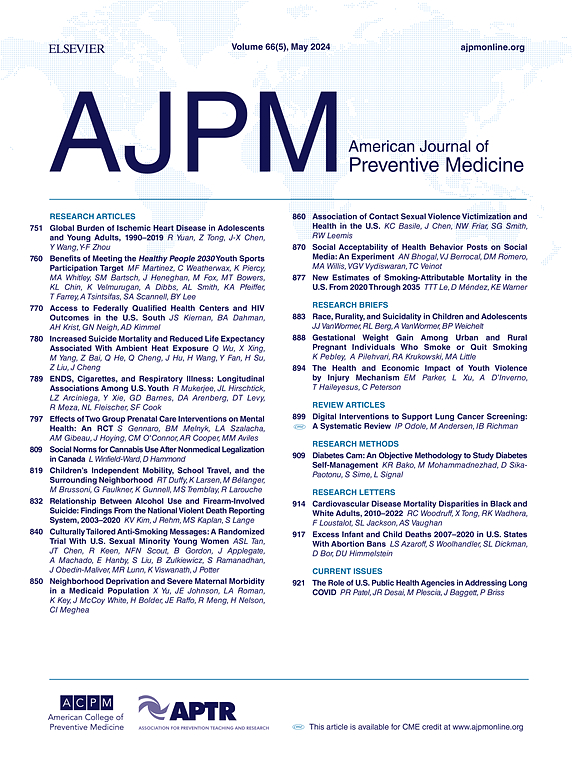美国警察涉枪杀人:谁中枪,中多少枪?
IF 4.3
2区 医学
Q1 MEDICINE, GENERAL & INTERNAL
引用次数: 0
摘要
在发达国家中,美国警察遭遇致命事件的比例最高。最近的案件突出表明,警察多次向个别嫌疑人开枪。这项研究旨在评估警察持枪杀人率的变化,以及被警察开枪打死的人中枪伤的数量。方法分析国家暴力死亡报告系统2023/2024年的数据,使用2005 - 2020年的数据估计人口中警察杀人的比率。负二项回归模型用于评估与警察枪支杀人死亡中枪伤数量增加相关的因素。结果在46个州和20.9亿人口年中,6.4%的枪支杀人案是由警察犯下的(n= 5241)。总共79%的警察受害者被枪击多次(平均5.98处枪伤),而65%的平民受害者被枪击多次(平均3.94处枪伤)。25-44岁的受害者每百万人年的警察枪支杀人率最高(5.23);男性(4.91);黑人(4.61),西班牙裔(3.76),美洲印第安人/阿拉斯加原住民(4.74);西部居民(4.65)。考虑到受害者的武器使用,年龄在35-44岁(IRR=1.13, 95% CI=1.03, 1.23)、黑人(IRR=1.10, 95% CI=1.02, 1.17)或东北部以外(IRR= 1.19-1.34)的人最有可能遭受更多的枪伤。结论:在枪支杀人案中,警察造成的枪伤比平民更多。那些年龄在25-44岁之间的黑人,或者住在东北部以外的人更有可能死于警察枪杀,每起死亡事件中枪伤的比例也更高。本文章由计算机程序翻译,如有差异,请以英文原文为准。
Firearm Homicides by Police in the United States: Who is Shot and How Many Times?
Introduction
The U.S. has the highest rate of deadly police encounters in the developed world. Recent cases highlight that police shoot individual suspects several times. This study aimed to assess variation in rates of police firearm homicide and the number of gunshot wounds among those shot and killed by police.
Methods
National Violent Death Reporting System was analyzed in 2023/2024, using data from 2005 to 2020 to estimate rates of police homicide across populations. Negative binomial regression models were used to evaluate factors associated with a greater number of GSWs among those who died due to police firearm homicide.
Results
Across 46 states and 2.09 billion person-years, 6.4% of all firearm homicides were by police (n=5,241). A total of 79% of police victims were shot multiple times (mean=5.98 gunshot wounds), compared with 65% of civilian victims (mean=3.94 gunshot wounds). The rate of police firearm homicide per million person-years was highest for victims aged 25–44 years (5.23); males (4.91); Black (4.61), Hispanic (3.76), and American Indian/Alaska Native people (4.74); and residents of the West (4.65). Accounting for victim weapon use, those aged 35–44 years (IRR=1.13, 95% CI=1.03, 1.23), who were Black (IRR=1.10, 95% CI=1.02, 1.17), or outside of the Northeast (IRRs=1.19–1.34) were most likely to suffer from more gunshot wounds.
Conclusions
In firearm homicides, police cause more gunshot wounds per fatality than civilians. Those who are aged 25–44 years, who are Black, or who live outside of the Northeast are more likely to die from police firearm homicide and have more gunshot wounds per fatality.
求助全文
通过发布文献求助,成功后即可免费获取论文全文。
去求助
来源期刊

American Journal of Preventive Medicine
医学-公共卫生、环境卫生与职业卫生
CiteScore
8.60
自引率
1.80%
发文量
395
审稿时长
32 days
期刊介绍:
The American Journal of Preventive Medicine is the official journal of the American College of Preventive Medicine and the Association for Prevention Teaching and Research. It publishes articles in the areas of prevention research, teaching, practice and policy. Original research is published on interventions aimed at the prevention of chronic and acute disease and the promotion of individual and community health.
Of particular emphasis are papers that address the primary and secondary prevention of important clinical, behavioral and public health issues such as injury and violence, infectious disease, women''s health, smoking, sedentary behaviors and physical activity, nutrition, diabetes, obesity, and substance use disorders. Papers also address educational initiatives aimed at improving the ability of health professionals to provide effective clinical prevention and public health services. Papers on health services research pertinent to prevention and public health are also published. The journal also publishes official policy statements from the two co-sponsoring organizations, review articles, media reviews, and editorials. Finally, the journal periodically publishes supplements and special theme issues devoted to areas of current interest to the prevention community.
 求助内容:
求助内容: 应助结果提醒方式:
应助结果提醒方式:


